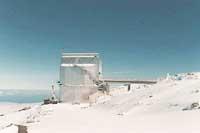More ice in space
2001/09/06 Imaz Amiano, Eneko - Elhuyar Zientziaren Komunikazioa
Lately, both on the Moon and on Mars, we have known their efforts in the search for ice. The goal is to increase our knowledge, but also to facilitate things in the conquest of space. In any case, ice is not something new in space, although it has generally been found as a cloud.

The team of scientists of the ‘Galileo National Telescope’, located in the Roque de los Muchachos Observatory of the Island of La Palma, has found on the surface of the planetarium Transneptuno 20000 VARUNA, frozen water at 200ºC. Planetesimal, similar in size to our moon, is beyond the orbit of Neptune, far from the Solar System. Objects beyond Neptune are probably the most primitive bodies of the Solar System, created as a result of the same collapse of the gas cloud produced by the Sun and the entire inner Solar System. His research is of great importance to know the chemical composition of matter in the early stages of the evolution of our planetary system.
The observations were made in the infrared band with a 3.6 m telescope. They have used the new spectroscopic tool designed and developed at the Arcetri Astrophysical Observatory. Instruments cited two centuries ago G. It also has a prisms system designed by the Italian optical Battista Amici. This system of prisms has significantly improved the quality of the observations, increasing the sensitivity of giant telescopes of 10 meters.
The data of the Galileo Telescope, like those obtained with the American Keck telescope of the Hawaii islands, are the best obtained through the observations made to date and will be published in the journal Astrophysics.

Gai honi buruzko eduki gehiago
Elhuyarrek garatutako teknologia






